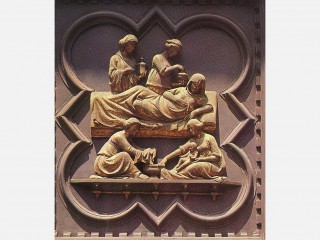
Andrea Pisano biography
Date of birth : -
Date of death : -
Birthplace : Pontedera, Pisa, Italy
Nationality : Italian
Category : Arhitecture and Engineering
Last modified : 2010-11-29
Credited as : Architect, doors for the Baptistery in Florence - image from left,
Andrea Pisano(ca. 1290-1348) was the most important 14th-century sculptor in Florence, as well as an architect.
Andrea Pisano, also called Andrea da Pontedera, was born in Pontedera near Pisa. He may have been trained in the shop of Tino di Camaino, a follower of Giovanni Pisano. Andrea's work before 1330 is unknown. According to Lorenzo Ghiberti, Andrea did many things for S. Maria della Spina, Pisa, though nothing extant can be assigned to him with certainty.
In a document of Jan. 22, 1330, Andrea's name appeared for the first time as maestro delle porte (artist of the doors) in connection with the first set of bronze doors for the Baptistery in Florence. He was capomastro of the Cathedral in Florence (1337-1340) and of the Cathedral in Orvieto (1347). He died sometime before July 19, 1348, when his son's name, Nino Pisano, appeared as capomastro in Orvieto.
The bronze doors of the Baptistery, which now adorn the south portal, are Andrea's masterpiece. In 1329 a member of the cloth merchants' guild, which was responsible for the decoration of the Baptistery, was sent to Pisa to study the doors of the Cathedral and later to Venice to secure a bronze founder for the project in Florence. According to a document of April 2, 1330, Andrea's wax model for the doors was finished. The doors, which were hung by March 15, 1336, are inscribed with Andrea's name. They consist of two large bronze wings decorated with 28 gilded reliefs set in quatrefoils. The lower 8 frames, 4 on each leaf of the doors, show the Seven Virtues plus Humility. The upper 20 frames tell the story of John the Baptist. In the narrative reliefs he relied on the mosaic cycle in the dome of the Baptistery and on Giotto's murals in the Peruzzi Chapel, Sta Croce, both of which tell the story of the Baptist. Andrea's style in these reliefs is Gothic and much closer to Giotto than to the Byzantine style of the mosaics.
The reliefs are medium high with, usually, a few figures moving across a shallow platform before architectural or landscape elements. The movements, dignified and restrained, spring from the rhythms Andrea established across the surface by deeply folded drapery and graceful, swaying postures. The figure sculpture is, in general, subordinate to the overall architectural framework of the portal.
Andrea was also responsible for a number of marble reliefs (1337-1340) on the two lowest registers of the Campanile of the Florentine Cathedral (now in the Cathedral Museum); in style they are similar to the bronze doors. A group of life-size kings, prophets, and sibyls (also in the Cathedral Museum) were intended to decorate niches in the Campanile. Though done more or less in Andrea's style, they are probably not autograph works. Two statues of Christ and St. Reparata (in the same museum), of remarkable quality, are commonly attributed to Andrea.
For the most up-to-date information on Andrea Pisano see John Pope-Hennessey, An Introduction to Italian Sculpture, vol. 1: Italian Gothic Sculpture (1955).
















